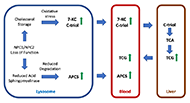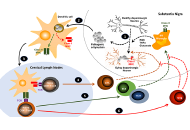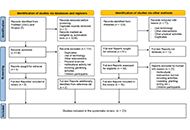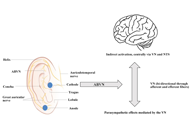131 results in Exploration of Neuroprotective Therapy
Most Cited
Sort by :
- Latest
- Most Viewed
- Most Downloaded
- Most Cited
Open Access
Review
Striking a balance: PIP2 and PIP3 signaling in neuronal health and disease
Kamran Tariq, Bryan W. Luikart
Published: October 29, 2021 Explor Neuroprot Ther. 2021;1:86–110
This article belongs to the special issue Cholesterol Dyshomeostasis in Neurological Diseases

Open Access
Review
Pathophysiology of non-motor signs in Parkinson’s disease: some recent updating with brief presentation
Khaled Radad ... Wolf-Dieter Rausch
Published: February 27, 2023 Explor Neuroprot Ther. 2023;3:24–46
This article belongs to the special issue Parkinson's Disease: Principal Targets and Interventional Mechanisms

Open Access
Review
Blocking cholesterol storage to treat Alzheimer’s disease
Ta Yuan Chang ... James G. Gow
Published: December 30, 2021 Explor Neuroprot Ther. 2021;1:173–184
This article belongs to the special issue Cholesterol Dyshomeostasis in Neurological Diseases

Open Access
Review
Advancing diagnosis and treatment of Niemann-Pick C disease through biomarker discovery
Xuntian Jiang, Daniel S. Ory
Published: December 30, 2021 Explor Neuroprot Ther. 2021;1:146–158
This article belongs to the special issue Cholesterol Dyshomeostasis in Neurological Diseases

Open Access
Review
Targeting α-synuclein aggregation with immunotherapy: a promising therapeutic approach for Parkinson’s disease
Gabriela Henriquez, Mahesh Narayan
Published: August 25, 2023 Explor Neuroprot Ther. 2023;3:207–234
This article belongs to the special issue Parkinsons Disease: Principal Targets and Interventional Mechanisms

Open Access
Review
Biomarkers in neurodegenerative diseases: a broad overview
Sathish Selvam, Velpandi Ayyavoo
Published: April 16, 2024 Explor Neuroprot Ther. 2024;4:119–147
This article belongs to the special issue The Future of Biomarkers in CNS Diseases

Open Access
Review
Balancing cholesterol in the brain: from synthesis to disposal
Lydia Qian ... Andrew J. Brown
Published: January 05, 2022 Explor Neuroprot Ther. 2022;2:1–27
This article belongs to the special issue Cholesterol Dyshomeostasis in Neurological Diseases

Open Access
Review
Subarachnoid hemorrhage: management considerations for COVID-19
Eric J. Panther, Brandon Lucke-Wold
Published: March 02, 2022 Explor Neuroprot Ther. 2022;2:65–73
This article belongs to the special issue Emerging Concepts in Subarachnoid Hemorrhage

Open Access
Review
The glymphatic system and subarachnoid hemorrhage: disruption and recovery
Stephan Quintin ... Brandon Lucke-Wold
Published: June 21, 2022 Explor Neuroprot Ther. 2022;2:118–130
This article belongs to the special issue Emerging Concepts in Subarachnoid Hemorrhage

Open Access
Review
Potentialities of IGF-1 for regulating oxidative stress in neuroinflammation and neurodegeneration: theoretical review
Macarena Lorena Herrera ... Claudia Beatriz Hereñú
Published: October 31, 2024 Explor Neuroprot Ther. 2024;4:442–458

Open Access
Systematic Review
Various facets of excitotoxicity
Talita Glaser ... Henning Ulrich
Published: February 23, 2022 Explor Neuroprot Ther. 2022;2:36–64

Open Access
Review
Economics of dry needling and botulinum toxin type A for treatment of post-stroke spasticity: a review
Daniel Fernández ... Eva María Gómez-Trullén
Published: June 30, 2022 Explor Neuroprot Ther. 2022;2:131–140
This article belongs to the special issue Dry Needling for Neurological Disorders

Open Access
Review
T-cell based immunotherapies for Parkinson’s disease
Rodrigo Pacheco
Published: October 29, 2021 Explor Neuroprot Ther. 2021;1:72–85

Open Access
Systematic Review
Effect of gardening physical activity on neuroplasticity and cognitive function
Antonio G. Lentoor
Published: June 05, 2024 Explor Neuroprot Ther. 2024;4:251–272
This article belongs to the special issue Empower Yourself - Physical Activity as Prevention and Rehabilitation of Neurological and Psychiatric Diseases

Open Access
Review
Neuroprotective astroglial response to neural damage and its relevance to affective disorders
José Javier Miguel-Hidalgo
Published: October 31, 2023 Explor Neuroprot Ther. 2023;3:328–345

Open Access
Review
Exploration of transcutaneous vagus nerve stimulation as a treatment option for adjuvant cancer and heart failure therapy
Niklas Frank ... Carola Y. Förster
Published: October 31, 2023 Explor Neuroprot Ther. 2023;3:363–397
This article belongs to the special issue Intervention of Neuroimmune Responses

Open Access
Review
Toll-like receptor 4 in the interface between neuroimmune response and behavioral alterations caused by stress
Fábio José Coelho Souza-Junior ... Sabrina Francesca Lisboa
Published: October 31, 2022 Explor Neuroprot Ther. 2022;2:182–209
This article belongs to the special issue Intervention of Neuroimmune Responses

Open Access
Review
The effects of post-translational modifications on alpha-synuclein aggregation and immune cell activation in Parkinson’s disease
Zaina Khan, Yoo Jin Jung
Published: October 26, 2023 Explor Neuroprot Ther. 2023;3:281–298
This article belongs to the special issue Parkinson's Disease: Principal Targets and Interventional Mechanisms

Open Access
Review
Stem cell therapy in neurological disorders: promises and concerns
Said Hachimi-Idrissi
Published: October 31, 2023 Explor Neuroprot Ther. 2023;3:346–362
This article belongs to the special issue Therapeutic Targets for Neuroprotection in Ischemic Stroke

Open Access
Perspective
Gut microbiota could modulate the effects of neuro-immune responses and memory traces via the gut-brain-immune axis in schizophrenia
Haruka Sawamura ... Satoru Matsuda
Published: April 24, 2022 Explor Neuroprot Ther. 2022;2:74–86
This article belongs to the special issue Intervention of Neuroimmune Responses

Journal Information
 Previous
Previous